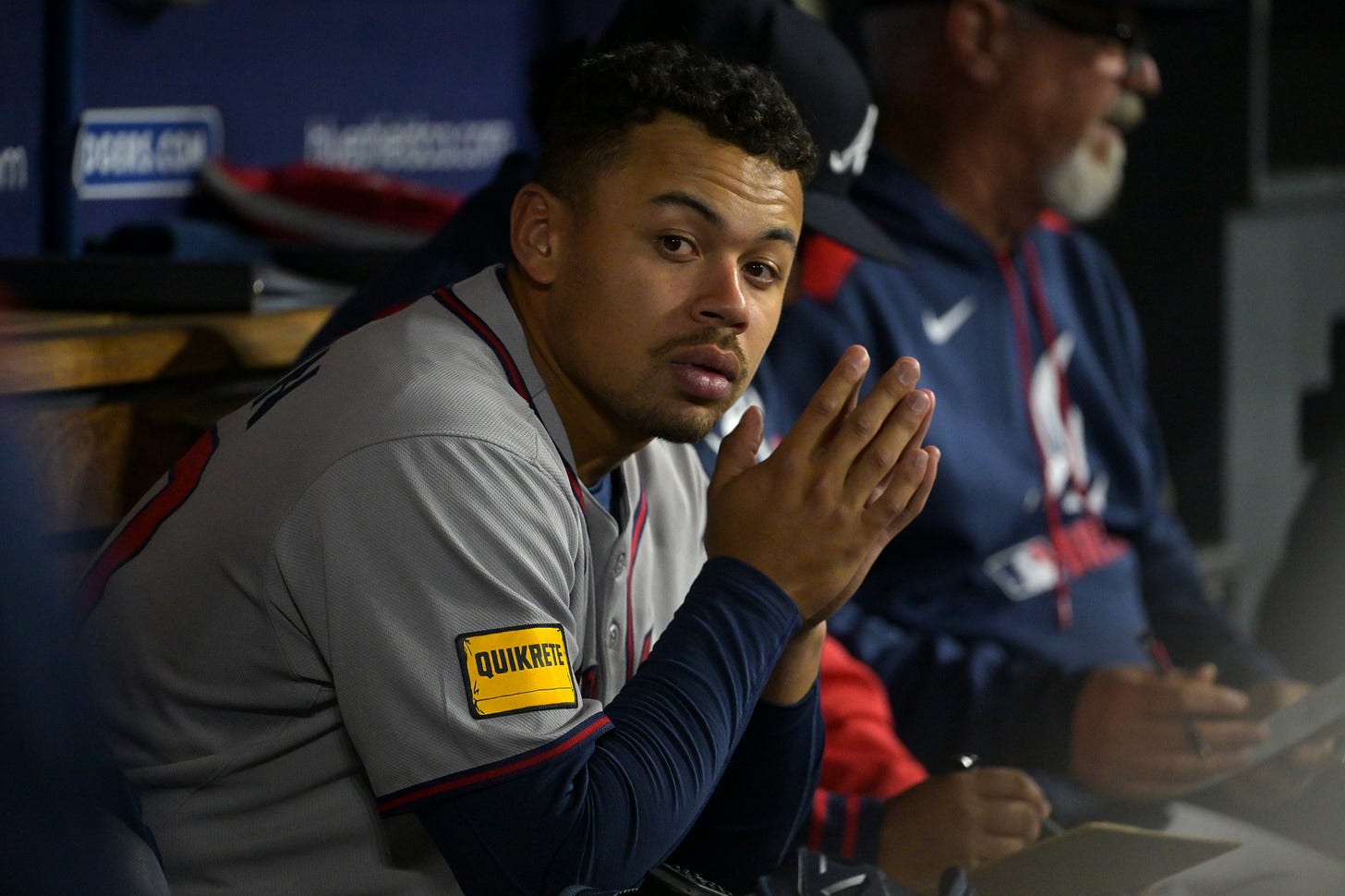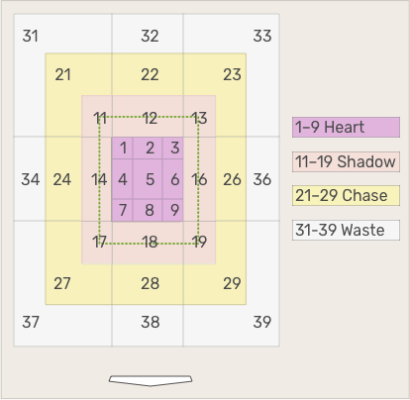It's very clear why the Atlanta Braves are keeping Drake Baldwin in the majors
Despite Sean Murphy returning from the injured list, the Braves front office recognizes that Baldwin's bat is special
Back when Sean Murphy first got hurt during spring training, the thought process behind promoting prospect Drake Baldwin for his MLB debut was “It’s just a few weeks.”
If he was bad, no worry - it was just a few weeks. And if he was just okay, well no worry - it was only a few weeks.
But this is different. Because Drake Baldwin’s not been bad and he’s not been merely ‘fine’. He’s been fantastic, even if the conventional statistics don’t show it just yet.
There’s a very clear and obvious reason the Braves decided to designate Chadwick Tromp for assignment and keep Baldwin in the majors.
Let’s talk about it.
The conventional stats are bad, but the inputs are most assuredly not
After Saturday’s contest, Baldwin’s hitting just .154/.241/.192 with no home runs and a single RBI.
(On defense, he’s also allowed eight stolen bases in nine attempts, but again, the conventional stats are misleading here.)
However, Drake Baldwin’s inputs are elite. Not good. Not very good. Elite.
Here’s the hitting portion of his Statcast card:
The card tells us that, along other things, Baldwin should be hitting .237 with a .533 slugging, using the expected stats1. That slug would be a Top 50 mark in baseball, slotting in right ahead of Fernando Tatis Jr. (.529) and right behind Jose Altuve (.545)
The expected stats are earned, too. Baldwin is among the league leaders in hard-hit rate at 61.9%, a 93rd percentile mark. He achieves that through exceptional bat speed of 75.1 mph, a 91st percentile mark.
He’s also been extremely unlucky on those hard-hit balls, too - the .249 point difference between his actual batting average (.154)) and his expected batting average (.403) on hard-hit balls is one of the worst marks in all of baseball.
But Baldwin’s also not missing many pitches. His whiff rate of 17.5% is 83rd percentile in all of the sport, despite his chase rate being just slightly above average at a 56th percentile mark of 26.7%.
Diving into how that whiff rate is so healthy for a young player leads us to a surprising observation: Yes he’s chasing, but not in a bad way. His zone contact is 83.8%, but his chase contact is also in the 80s at an even 80%.
Even when he expands the zone, he’s making a lot of contact. How?
His pitch recognition is already elite
The reason for Drake Baldwin's chase contact rate being so high is that he’s not expanding the zone a lot. He sees one in four pitches in MLB’s “chase zone”, which is perfectly average. He swung at exactly five2 of those 34 pitches, with four of them coming on two-strike counts and only one resulting in a strikeout. The average MLB hitter chases close to 22% of the time at those pitches.
But pitches in the shadow, that can be either a ball or a strike? He’s seen 67 of them (exactly half of all the pitches he’s seen so far). He took 16 of them for balls, 15 for called strikes, whiffed at five of them, fouled 19 off, and put 12 into play.
The aggregation of those numbers: 51 strikes on 36 swings/15 takes with 16 balls.
So yes, he’s chasing a league-average amount overall, but they’re very high-quality swing decisions - remember, any ball in the shadow zone is by definition a 50/50 ball, being one baseball width on either side of the border of the strike zone. Most MLB hitters swing around 50% of the time there. Baldwin’s at 76%. And he’s making contact a lot when he does it, too - 86.1% of the time. MLB average is below 50%.3
Subscription break! We’re adding more premium subs every single day - shout out to our newest premium subscriber Cynda, who upgraded from a free to an annual sub on Sunday morning. If you’re a frequent reader and/or find yourself really appreciating what we do both here and on the YouTube channel, which includes daily podcasts and video of media availabilities, why not become a paying member? It’s $6/month or $69 a year, and it helps support everything we’re going over here on Braves Today.
Pitchers already respect him
Out of the 134 pitches seen by Baldwin this year, only 23 have been in the heart of the zone. MLB average is 26.5% so far this season (through Saturday’s games), but he’s at only 17.2%. He’s hitting .286 on those (2-7).4
MLB average on pitches in the heart of the plate is actually slightly better than what Baldwin’s put up - the league’s hitters are collectively hitting .298 (with an xBA of .319) - but it’s clear that opposing pitchers have enough of a scouting report on Baldwin to not give him a cookie.
Now, that doesn’t mean that Baldwin’s a completely finished product; there are still a few areas where he can improve at the plate. We’re getting to those.
But while the conventional statistics don’t properly convey the quality of his at-bats, the inputs are those of someone who is absolutely already an above-average major-league hitter.
There are still things to improve on, though
Digging through all these numbers, there are still a few things I would like Baldwin to continue working on while he’s in the majors.
The first is jumping on those gift pitches. He’s seen six pitches this year in attack zone five5 - right down the absolute heart of the plate. Middle-middle. Meatball. Down the d***.6
He’s swung only twice, grounding one to short and the other back to the pitcher (and off of him, over to Luis Arraez for the out at first base).
Tim Hyers is coaching these hitters to be aggressive on “your” pitch. Any pitch in attack zone five should be your pitch, really.
The second area is his launch angles, which we already knew was an issue. In Gwinnett last year, he left 50% of his batted balls on the ground.
In Atlanta, it’s been better. He’s currently at 47.6% groundballs, slightly above this season’s MLB average but nothing egregious. However, it’s almost a bit of an overcorrection - he’s hitting 42.9% of his batted balls in the air and only 9.5% as line drives, versus the MLB averages of 23.8% FB and 24.7% LD.
The reason this matters: this season, fly balls have a batting average of .261 and line drives have a .632.7
So, to recap:
Despite the conventional statistics not yet reflecting the high quality of these at-bats, Drake Baldwin’s hitting the ball hard by combining one of MLB’s best swing speeds with not chasing outside of the edges of the strike zone. While he’s not yet hitting enough line drives, instead hitting a lot of fly balls, he’s not getting egregiously underneath the ball and popping it up either.
It makes perfect sense to keep this kid in Atlanta. While he’s never played outfield in a professional game, there’s an argument to be made to try either him or Marcell Ozuna out there so that both of their bats can be in the lineup at the same time.
And even if the Braves don’t sacrifice defense by having one of those two out in the grass, the timeshare between Baldwin and Murphy is likely closer to even than we were expecting the division of starts to be between Tromp and Murphy.
As you may remember, Statcast’s expected stats are based on similar batted balls of that exit velocity, launch angle, and direction.
One swinging strike, a groundout, a lineout, and two foul balls.
41.51% so far this season, working backward from 1,157 whiffs in 1,978 swings
Against an expected batting average of .285, so we’ll take that
I honestly think several of these were mistakes. That can’t be the intended location for a sweeper (Anthony Banda on Saturday, Michael King in the season opener) or even a slider (Dylan Cease, Adrian Morejon). Only one of those was a four-seam fastball, off of Tyler Glasnow, and that was the groundout to short.
Sorry, Mom
To complete this, ground balls have a .245 (which is higher than I expected, honestly), and pop-ups, which Baldwin hasn’t done a single time, are at .031.








So far the outfielder-2nd baseman Hartman for Augusta is my early season star.
Also outfielders Isiah Drake and Covey look good for Augusta.